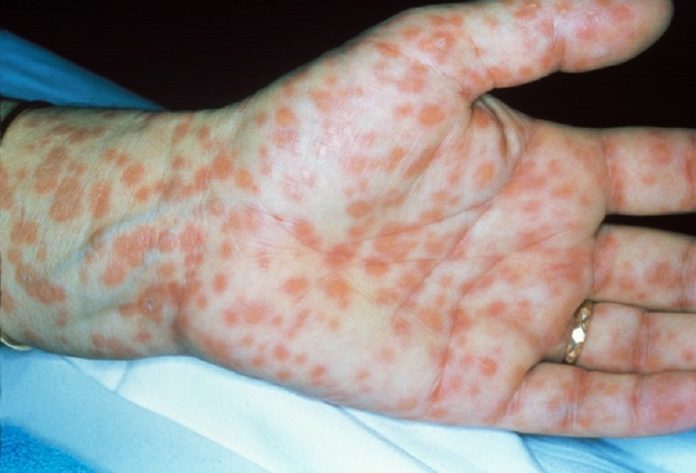You may have seen stories in the press about diseases you might have thought had been eradicated, such as the bubonic plague, tuberculosis, and measles. If you find this worrying, you’re not the only one. Sometimes these diseases reemerge due to people refusing to be vaccinated, and others mutate to become stronger and untreatable by previously effective medication.
15. Tuberculosis

Before the bacterium Mycobacterium tuberculosis was discovered in 1882, one of every seven people who died in Europe and the USA died of tuberculosis. Luckily, antibiotics have made it much less dangerous, especially in the USA. Tuberculosis can be cured, although it’s a long process with a number of antibiotics having to be used for up to a year. However, experts are warning that new antibiotic-resistant strains of tuberculosis are appearing globally.
14. Rubella

A.k.a. German measles, rubella, the symptoms of which are quite like those of ordinary measles, is a contagious viral disease. Women who catch the disease in the early stages of pregnancy may suffer damage to the fetus. With the invention of the MMR vaccine, rubella became almost nonexistent in the USA. Nevertheless, the number of cases is on the rise, and the disease can have such devastating effects that even a small rise in cases is worrying. Get your kids frequently checked at the doctor if you can afford it.
13. Cholera

Cholera, causing severe dehydration, can kill a healthy adult within hours. Fortunately, in the 19th century, it was discovered that contaminated water was responsible for the disease and this accelerated the development of clean water systems. However, this has not eliminated the disease in poorer parts of the world where clean water supplies can be hard to come by. In regions where cholera still exists, it remains as fatal as ever.
12. Plague

Plague devastated the world in the Middle Ages, but you might have thought we’d seen the last of it. Not so: it still exists in areas of Asia, Africa, and South America, and 16 cases have emerged in the USA in the last 12 months. Infected rodents carry the Yersina pestis bacteria, and humans can contract plague either by being bitten by fleas from the rodents or through contact with infected animals. In the USA the most common type of plague is bubonic plague; although this is serious enough, fortunately at the moment the even more dangerous pneumonic plague (which attacks the lungs) and septicemic plague (which attacks the blood) are less common.
11. Scarlet fever

Scarlet fever was first identified in the 1500s. It is a form of bacterial illness that certain individuals with strep throat will develop. Sufferers develop high temperatures and a bright red rash over the majority of their skin. By the 1960s scarlet fever had almost disappeared; however, in 2015 the UK experienced more than 14,000 cases of the disease, the highest level in two decades.
10. Whooping cough

Whooping cough is a disease most frequently suffered by children; it’s extremely contagious and infects the respiratory tract, causing a very painful hacking cough. The disease was eradicated in the 1940s through the use of vaccines, but it has recently been resurgent. This is most probably because the vaccine has been modified and immunity levels are dropping. The USA had more cases of whooping cough in 2012 than it had experienced for over 50 years. Unless an improved vaccine can be found, it is feared that disease rates could continue to rise until they represent a serious epidemic.
9. Syphilis

Syphilis is another disease that seemed on the way out, but the infection, which is sexually transmitted, has been increasing since the turn of the century. Sufferers experience sores or ulcers and whole body rashes, particularly noticeable on the palms and soles of the feet. Luckily, syphilis can still be quickly treated with penicillin. Still, using a condom could save you from this nightmare.
8. Gout

Gout has risen by over 100% in the USA in the past two decades. It is a form of inflammatory arthritis caused by uric acid crystallizing in joints, causing serious swelling and pain. Gout is becoming more common due to the rise of obesity, hypertension, and metabolic syndrome in the USA. Gout and hyperuricemia can be controlled by reducing hypertension and obesity.
7. Mumps

Mumps is an extremely contagious viral condition that makes the parotid saliva glands in the face swell painfully. The MMR vaccine caused incidences of mumps to dramatically decrease, but the increasing number of parents refusing to have their children vaccinated is causing them to rise again.
6. Rickets

Rickets, generally caused by a severe lack of vitamin D, causes children’s bones to become soft and weak. It had virtually disappeared from Western countries, but over the last 10 years it has been on the rise in the US and Europe; England alone has experienced several hundred cases recently. This may be attributable to the increasingly poor diet fed to children and the lower amounts of time they spend outdoors compared to previous generations.
5. Measles

Measles was at one time a very common disease, with virtually every American child suffering from it at some point before they reached fifteen years of age; between 400 and 500 people died from it every year in the USA. However, by the year 2000, thanks to the vaccination program running from the 1960s onwards, it had virtually disappeared in the USA. No medical treatment for measles exists, making vaccination essential. Recently, measles cases have been on the rise, which experts attribute to a fall in the numbers of vaccinated individuals. In some instances, those without vaccinations may contract the disease abroad and then pass it on to other unvaccinated individuals when they return home.
4. Polio

Polio, first identified in 1789, is a very serious virus that may cause breathing problems and paralysis, ultimately leading to death in up to 10% of cases. In the middle of the 20th century, a global polio epidemic appeared, killing nearly half a million people every year (35,000 on average in the USA). Although the polio vaccine is almost infallible in saving people from catching polio, infection rates have been rising in the Middle East and Africa in recent times.
3. Legionnaires’ disease

Incidences of Legionnaires’ disease have increased in recent years. Legionnaires’ disease is a lung infection caused by inhaling invisible water droplets carrying the Legionella bacteria. It first manifests as a flu-like condition, developing into an ineradicable cough, pains in the chest, and breathing problems. It can be cured with antibiotics, but if the first symptoms are missed it can become serious, even fatal, especially in older patients.
2. Yellow fever

Yellow fever is carried by mosquitoes, and human victims of the disease suffer kidney and liver damage, fevers, and jaundice, and it is frequently fatal. In 1793, in Philadelphia, an outbreak of yellow fever killed 5000 citizens. In the Western world, the disease has been almost eliminated, but this is not the case for other regions. Mosquitoes carrying yellow fever were found in some cities in South America in 2013, and it is feared that the disease could easily take hold again and spread north. Yellow fever is one good reason to get travel insurance when you visit affected areas.
1. Scurvy

You might think that scurvy was only suffered by 18th-century sailors and that it was eliminated through the use of lime juice. This isn’t quite the whole story. Scurvy comes from severe vitamin C deficiency, and this can still occur today. The disease can cause bleeding gums and tooth loss. It frequently appears in older people, alcoholics, those who don’t eat fruits and vegetables, and men living alone (“widower scurvy”). Fortunately, simple vitamin C supplements offer an effective treatment. Trip to the dentist, anyone?


































